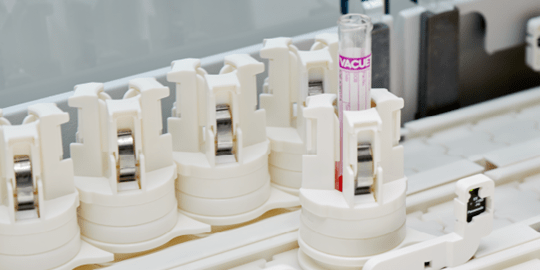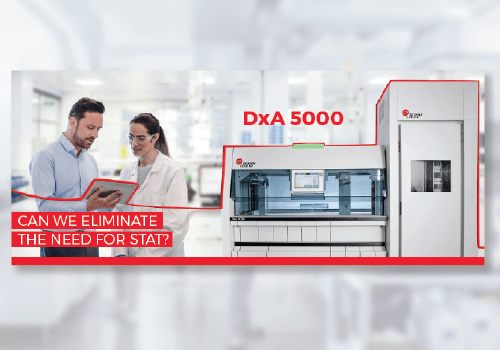We know that clinical laboratories struggle with consistency in delivering results. One day laboratory test results are turned out in an hour; another day, it takes an hour and a half.
Tests may be classified as STAT when they are needed urgently for immediate patient care. But if the hospital lab is bombarded with STAT tests that shouldn’t really be labeled STAT, already-constrained resources are put under undue pressure. Some labs have turned to automation for help, but if their automation system does not differentiate between STATs and routines, it will simply route samples as they come in with no preferential processing. This can lead to inconsistent, and inappropriate, turnaround times for all samples.
Beckman Coulter’s new total laboratory automation system, the DxA 5000, can help with these intractable challenges. By leveraging intelligent routing capabilities, the system differentiates STATs from routines to ensure each sample is appropriately prioritized.
Embedded intelligence
The DxA 5000 delivers this capability by embedding intelligence into every piece of the pre-analytical, analytical, and post-analytical workflow in the clinical lab—from sample entry to sample archive. The system’s proprietary software combines laboratory-defined priorities with dynamically updated workflow constraints to ensure tests are always appropriately prioritized and all tubes travel the most efficient route possible.
In addition, the system is supported by the rules engine of REMISOL Advance middleware. We understand that not all laboratories are the same—some prioritize Emergency Department tests, others prioritize ICU tests, for example. Laboratories can define their own priorities in REMISOL Advance, and the DxA 5000 follows those rules.
Smart tube transit
Imagine you’re traveling a busy highway going from point A to point B. At night, it takes you 45 minutes. During the day, heavier traffic means it takes you 2 hours. An automation track in a laboratory may function in much the same way.
For instance, when there are relatively few tubes to process, test results can be delivered within 60 minutes. However, when there are 1,000 or more tubes on the line, it’s going to take longer—and worse, this traffic often makes it impossible for STAT samples to bypass routines.
Unlike other automation systems, the DxA 5000 thrives in scenarios like this. Its intelligent routing capabilities act like a smart global positioning system (GPS), constantly calculating the most expeditious path for all tubes and routing them accordingly. Here’s an example of how it works: First, the system determines the analytical destination for a tube—in this case, it’s a clinical chemistry analyzer. It then calculates the tube’s time to that destination and starts to route it. Let’s say that, while the tube is en route, the chemistry analyzer encounters an issue—perhaps a QC drift. REMISOL Advance immediately detects this issue and alerts the system, prompting it to reroute the tube around the analyzer in question until the issue is resolved. Throughout this process, the system is hard at work, continuously prioritizing STAT samples ahead of routines.
Advantages of laboratory automation
According to Dr. Ralf Triepels from Bravis Hospital in the Netherlands: "With intelligent sample routing we can [adjust to] problems at the beginning of the process, which gives us time to react appropriately. It is this feature that we found to be most unique about the DxA 5000. We were searching for a solution that would give us total process control, and help us ‘make STAT samples history.’ Beckman Coulter delivered this opportunity for us. With the DxA 5000, we are delivering all results in less than 60 minutes."
Delivering the kind of fast, consistent turnaround times Dr. Triepels mentioned is what intelligent routing is ultimately all about. In the end, every hospital should explore bringing this capability into the laboratory to help sustain maximum productivity, preserve high-quality results, and drive enhanced patient care.
For more information on intelligent routing or Beckman Coulter’s automation technology, visit: beckmancoulter.com/DxA5000.

 English
English






